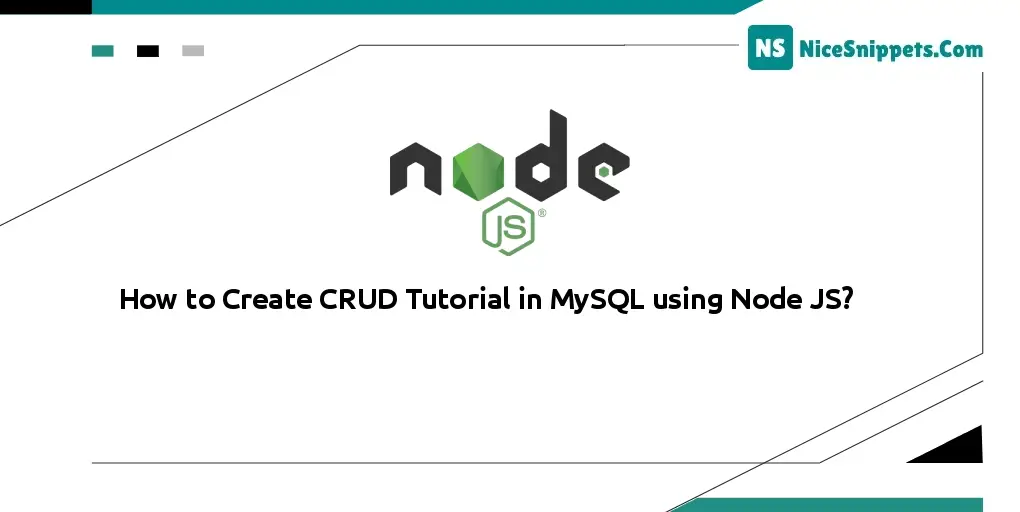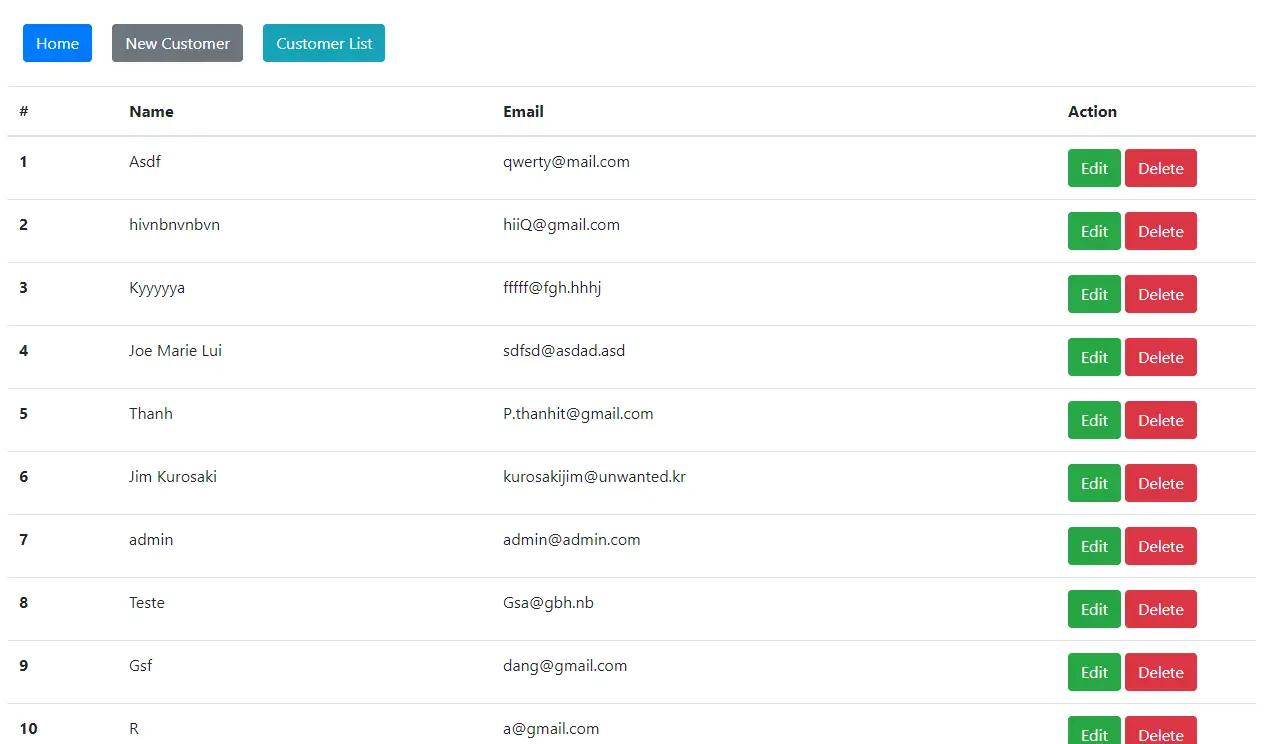13-Jan-2023
.
Admin

Hello Friends,
Today, node js crud example with MySQL is our main topic. I explained simply step-by-step node.js express MySQL crud example. you'll learn crud operation in node js using express MySQL. this example will help you with node js crud API with MySQL. you will do the following things for the node js crud API tutorial.
In this tutorial, we will create a very simple way to crud rest API using node js and MySQL. we will use express, MySQL, and body-parser npm package for creating crud API with node.js and MySQL. you will find the following apis after follow full this example:
Step 1: Create Node JS App
Execute the following command on the terminal to create node js express app:
Use the below command and create your express project with the name expressfirst
express --view=ejs expressfirst
After successfully creating an express first folder in your system. Next follow the below commands and install node js in your project:
cd expressfirst
npm install
Step 2: Install Required Libraries
Install flash, validator,session,override MySQL Libraries into your node js express crud + MySQL application by executing the following command on the terminal:
npm install express-flash --save
npm install express-session --save
npm install express-validator --save
npm install method-override --save
npm install mysql --save
express-flash
Flash is an extension of connect-flash with the ability to define a flash message and render it without redirecting the request.
In this node js MySQL crud tutorial express flash is used to display a warning, error, and information message
express-session
Express-session is used to make a session like in PHP. In this node js MySQL crud tutorial, the session is needed as the express requirement of express-flash.
express-validator
Express-validator is used to validate form data it is easy to use. an express-validator highly effective and efficient way to accelerate the creation of applications.
method-override
NPM is used to run a DELETE and PUT method from an HTML form. Several web browsers only support GET and POST methods.
MySQL
Driver to connect node.js with MySQL
Step 3: Connect to Node js Express MySQL CRUD App
Create one folder name lib and create a new file name db.js inside this folder. We will connect node js to MySQL using this file
lib/db.js
var mysql=require('mysql');
var connection=mysql.createConnection({
host:'localhost',
user:'your username',
password:'your password',
database:'your database name'
});
connection.connect(function(error){
if(!!error){
console.log(error);
}else{
console.log('Connected!:)');
}
});
module.exports = connection;
Step 4: Create Server.js File
Visit your app root directory and create a new file name server.js And add the following code to it:
var createError = require('http-errors');
var express = require('express');
var path = require('path');
var cookieParser = require('cookie-parser');
var logger = require('morgan');
var expressValidator = require('express-validator');
var flash = require('express-flash');
var session = require('express-session');
var bodyParser = require('body-parser');
var mysql = require('mysql');
var connection = require('./lib/db');
var indexRouter = require('./routes/index');
var usersRouter = require('./routes/users');
var customersRouter = require('./routes/customers');
var app = express();
// view engine setup
app.set('views', path.join(__dirname, 'views'));
app.set('view engine', 'ejs');
app.use(logger('dev'));
app.use(bodyParser.json());
app.use(bodyParser.urlencoded({ extended: true }));
app.use(cookieParser());
app.use(express.static(path.join(__dirname, 'public')));
app.use(session({
secret: '123456cat',
resave: false,
saveUninitialized: true,
cookie: { maxAge: 60000 }
}))
app.use(flash());
app.use(expressValidator());
app.use('/', indexRouter);
app.use('/users', usersRouter);
app.use('/customers', customersRouter);
// catch 404 and forward to error handler
app.use(function(req, res, next) {
next(createError(404));
});
// error handler
app.use(function(err, req, res, next) {
// set locals, only providing error in development
res.locals.message = err.message;
res.locals.error = req.app.get('env') === 'development' ? err : {};
// render the error page
res.status(err.status || 500);
res.render('error');
});
// port must be set to 3000 because incoming http requests are routed from port 80 to port 8080
app.listen(3000, function () {
console.log('Node app is running on port 3000');
});
module.exports = app;
Step 5: Create CRUD Routes
Create crud route file name customers.js; so visit inside routes folder and create this file. Then add the following code into it:
var express = require('express');
var router = express.Router();
var connection = require('../lib/db');
/* GET home page. */
router.get('/', function(req, res, next) {
connection.query('SELECT * FROM customers ORDER BY id desc',function(err,rows){
if(err){
req.flash('error', err);
res.render('customers',{page_title:"Customers - Node.js",data:''});
}else{
res.render('customers',{page_title:"Customers - Node.js",data:rows});
}
});
});
// SHOW ADD USER FORM
router.get('/add', function(req, res, next){
// render to views/user/add.ejs
res.render('customers/add', {
title: 'Add New Customers',
name: '',
email: ''
});
});
// ADD NEW USER POST ACTION
router.post('/add', function(req, res, next){
req.assert('name', 'Name is required').notEmpty() //Validate name
req.assert('email', 'A valid email is required').isEmail() //Validate email
var errors = req.validationErrors()
if( !errors ) {
//No errors were found. Passed Validation!
var user = {
name: req.sanitize('name').escape().trim(),
email: req.sanitize('email').escape().trim()
}
connection.query('INSERT INTO customers SET ?', user, function(err, result) {
//if(err) throw err
if (err) {
req.flash('error', err)
// render to views/user/add.ejs
res.render('customers/add', {
title: 'Add New Customer',
name: user.name,
email: user.email
});
} else {
req.flash('success', 'Data added successfully!');
res.redirect('/customers');
}
});
};
else {
//Display errors to user
var error_msg = ''
errors.forEach(function(error) {
error_msg += error.msg + '<br>'
})
req.flash('error', error_msg)
/**
* Using req.body.name
* because req.param('name') is deprecated
*/
res.render('customers/add', {
title: 'Add New Customer',
name: req.body.name,
email: req.body.email
});
}
});
// SHOW EDIT USER FORM
router.get('/edit/(:id)', function(req, res, next){
connection.query('SELECT * FROM customers WHERE id = ' + req.params.id, function(err, rows, fields) {
if(err) throw err
// if user not found
if (rows.length <= 0) {
req.flash('error', 'Customers not found with id = ' + req.params.id)
res.redirect('/customers')
}
else {
// if user found
// render to views/user/edit.ejs template file
res.render('customers/edit', {
title: 'Edit Customer',
//data: rows[0],
id: rows[0].id,
name: rows[0].name,
email: rows[0].email
});
}
});
});
// EDIT USER POST ACTION
router.post('/update/:id', function(req, res, next) {
req.assert('name', 'Name is required').notEmpty() //Validate nam //Validate age
req.assert('email', 'A valid email is required').isEmail() //Validate email
var errors = req.validationErrors()
if( !errors ) {
var user = {
name: req.sanitize('name').escape().trim(),
email: req.sanitize('email').escape().trim()
}
connection.query('UPDATE customers SET ? WHERE id = ' + req.params.id, user, function(err, result) {
//if(err) throw err
if (err) {
req.flash('error', err)
// render to views/user/add.ejs
res.render('customers/edit', {
title: 'Edit Customer',
id: req.params.id,
name: req.body.name,
email: req.body.email
});
} else {
req.flash('success', 'Data updated successfully!');
res.redirect('/customers');
}
});
}else {
//Display errors to user
var error_msg = ''
errors.forEach(function(error) {
error_msg += error.msg + '<br>'
})
req.flash('error', error_msg)
/**
* Using req.body.name
* because req.param('name') is deprecated
*/
res.render('customers/edit', {
title: 'Edit Customer',
id: req.params.id,
name: req.body.name,
email: req.body.email
});
}
});
// DELETE USER
router.get('/delete/(:id)', function(req, res, next) {
var user = { id: req.params.id }
connection.query('DELETE FROM customers WHERE id = ' + req.params.id, user, function(err, result) {
//if(err) throw err
if (err) {
req.flash('error', err)
// redirect to users list page
res.redirect('/customers')
} else {
req.flash('success', 'Customer deleted successfully! id = ' + req.params.id)
// redirect to users list page
res.redirect('/customers')
}
});
});
module.exports = router;
Step 6: Create views
First we will create one folder name customers inside the views folder.
Next we need to create three views file names add.ejs, edit.ejs, and index.ejs. We will create three view files inside the views/customers folder.
Create first file index.ejs
Index.ejs file, we will display the list of customers.
<!DOCTYPE html>
<html>
<head>
<title>Customers</title>
<link rel='stylesheet' href='/stylesheets/style.css' />
<script src="https://code.jquery.com/jquery-3.3.1.min.js"></script>
<script src="https://stackpath.bootstrapcdn.com/bootstrap/4.1.3/js/bootstrap.min.js" integrity="sha384-ChfqqxuZUCnJSK3+MXmPNIyE6ZbWh2IMqE241rYiqJxyMiZ6OW/JmZQ5stwEULTy" crossorigin="anonymous"></script>
<link href="https://stackpath.bootstrapcdn.com/bootstrap/4.1.3/css/bootstrap.min.css" rel="stylesheet" integrity="sha384-MCw98/SFnGE8fJT3GXwEOngsV7Zt27NXFoaoApmYm81iuXoPkFOJwJ8ERdknLPMO" crossorigin="anonymous">
</head>
<body>
<div>
<a href="/" class="btn btn-primary ml-3">Home</a>
<a href="/customers/add" class="btn btn-secondary ml-3">New Customer</a>
<a href="/customers" class="btn btn-info ml-3">Customer List</a>
</div>
<!-- <% if (messages.error) { %>
<p style="color:red"><%- messages.error %></p>
<% } %> -->
<% if (messages.success) { %>
<p class="alert alert-success mt-4"><%- messages.success %></p>
<% } %>
<br>
<table class="table">
<thead>
<tr>
<th scope="col">#</th>
<th scope="col">Name</th>
<th scope="col">Email</th>
<th width="200px">Action</th>
</tr>
</thead>
<tbody>
<% if(data.length){
for(var i = 0; i< data.length; i++) {%>
<tr>
<th scope="row"><%= (i+1) %></th>
<td><%= data[i].name%></td>
<td><%= data[i].email%></td>
<td>
<a class="btn btn-success edit" href="../customers/edit/<%=data[i].id%>">Edit</a>
<a class="btn btn-danger delete" onclick="return alert('Are You sure?')" href="../customers/delete/<%=data[i].id%>">Delete</a>
</td>
</tr>
<% }
}else{ %>
<tr>
<td colspan="3">No user</td>
</tr>
<% } %>
</tbody>
</table>
</body>
</html>
Create second file name add.ejs
Add.ejs file, we will create a form for sending to data in the database.
<!DOCTYPE html>
<html>
<head>
<title>Customers</title>
<link rel='stylesheet' href='/stylesheets/style.css' />
<script src="https://code.jquery.com/jquery-3.3.1.min.js"></script>
<script src="https://stackpath.bootstrapcdn.com/bootstrap/4.1.3/js/bootstrap.min.js" integrity="sha384-ChfqqxuZUCnJSK3+MXmPNIyE6ZbWh2IMqE241rYiqJxyMiZ6OW/JmZQ5stwEULTy" crossorigin="anonymous"></script>
<link href="https://stackpath.bootstrapcdn.com/bootstrap/4.1.3/css/bootstrap.min.css" rel="stylesheet" integrity="sha384-MCw98/SFnGE8fJT3GXwEOngsV7Zt27NXFoaoApmYm81iuXoPkFOJwJ8ERdknLPMO" crossorigin="anonymous">
</head>
<body>
<% if (messages.error) { %>
<p style="color:red"><%- messages.error %></p>
<% } %>
<% if (messages.success) { %>
<p style="color:green"><%- messages.success %></p>
<% } %>
<form action="/customers/add" method="post" name="form1">
<div class="form-group">
<label for="exampleInputPassword1">Name</label>
<input type="text" class="form-control" name="name" id="name" value="" placeholder="Name">
</div>
<div class="form-group">
<label for="exampleInputEmail1">Email address</label>
<input type="email" name="email" class="form-control" id="email" aria-describedby="emailHelp" placeholder="Enter email" value="">
</div>
<input type="submit" class="btn btn-primary" value="Add">
</form>
</body>
</html>
Create third file name edit.ejs
Next create the last file edit. ejs, we will edit data in this form.
<!DOCTYPE html>
<html>
<head>
<title>Customers</title>
<link rel='stylesheet' href='/stylesheets/style.css' />
<script src="https://code.jquery.com/jquery-3.3.1.min.js"></script>
<script src="https://stackpath.bootstrapcdn.com/bootstrap/4.1.3/js/bootstrap.min.js" integrity="sha384-ChfqqxuZUCnJSK3+MXmPNIyE6ZbWh2IMqE241rYiqJxyMiZ6OW/JmZQ5stwEULTy" crossorigin="anonymous"></script>
<link href="https://stackpath.bootstrapcdn.com/bootstrap/4.1.3/css/bootstrap.min.css" rel="stylesheet" integrity="sha384-MCw98/SFnGE8fJT3GXwEOngsV7Zt27NXFoaoApmYm81iuXoPkFOJwJ8ERdknLPMO" crossorigin="anonymous">
</head>
<body>
<form action="/customers/update/<%= id %>" method="post" name="form1">
<div class="form-group">
<label for="exampleInputPassword1">Name</label>
<input type="text" class="form-control" name="name" id="name" value="<%= name %>" placeholder="Name">
</div>
<div class="form-group">
<label for="exampleInputEmail1">Email address</label>
<input type="email" class="form-control" name="email" id="email" aria-describedby="emailHelp" placeholder="Enter email" value="<%= email %>">
</div>
<button type="submit" class="btn btn-info">Update</button>
</form>
</body>
</html>
Step 7: Start Node Express js Crud + MySQL app
run the below command
npm start
After running this command open your browser and hit
http://127.0.0.1:3000/customers
Node js express crud tutorial MySQL will looks like:



I hope it can help you...
#Node JS